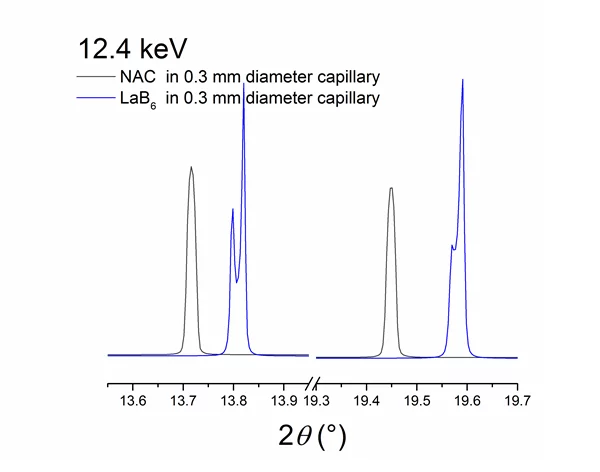MESQUIK is a MEasurement Service for QUIcK high quality data collection obtained by routine analyses on a limited number of samples at the Material Science Beamline X04SA. Samples are sent to PSI and relative data are sent back by mail. It is presently in beta mode and might be temporarily halted if needed. We propose for all the academic research community (except for industrials) to measure your samples:
- choosing one of three different energies/wavelengths: 12.4 keV/1Å, 17.5 keV/0.7085Å and 22 keV /0.5636Å
- choosing out of three different capillary diameters: 0.1 mm, 0.3 mm and 0.5 mm.
- fixed angular range 1-90 degrees - fixed data collection mode
Each request to MESQUIK is subject to a short (max 1 page) proposal submission with a quick peer review process. Our present aim is less than 10 weeks from proposal submission to delivery of data in your mailbox, if time is respected for deliveries of sample. For each proposal, 5 measurements are allowed for a maximum of 5 samples, justification of the need for synchrotron radiation is expected. For example, one sample measured at two different energies is considered as two measurements. Experiments requiring more samples must submit a standard proposal via the standard Call of Proposals (two deadlines per year). The call for MESQUIK proposals is continuously open from the beginning of January to the end of November. Proposals can only be considered if they are submitted electronically using the SLS Digital Users Office (DUO). After the positive acceptance of your proposal, the preparation of the capillaries is in your charge as well as the shipment to the MESQUIK service.
Before submitting your proposal to the MESQUIK service please read the steps below.
1) Have your samples ready
MESQUIK is a rapid measurement service for existing samples. There is no point of using the service if there is no urgency/ready sample.
2) Choice of Experimental conditions
A standard data acquisition routine is available for three different energies: 12.4 keV, 17.5 keV and 22.0 keV with three capillary diameters: 0.1 mm, 0.3 mm and 0.5 mm. Please note capillaries of other diameters will not be coming with a standard of similar dimensions.
Experimental conditions: The sample is irradiated by an unfocused beam on a constant area of 4 mm horizontally. Vertically, the beam is slit depending on the size of the capillary such as 0.6 mm vertical slit aperture for a 0.5 mm-diameter capillary. Data are presently collected on your capillary at room temperature with the Mythen II. The collected data is automatically sent by email in a 3 column data file (2θ, Intensity, Error) coming along with the standard data of the Si640d and the NAC . For further information for data processing, see step 9.
How to choose? Before submitting your proposal, you should seriously consider your needs and which configuration is the most suited for your samples to exploit optimally the MESQUIK service. To choose the right energy and capillary size for your experiment you should consider:
a) Fluorescence
Which elements do you have in your samples ? Where are their absorption edges? It will guide you for the energy to choose. Fluorescence reduces considerably the quality of the collected data i.e. decreasing the signal-to-noise ratio and affecting in a non statistic way the background itself. It has to be avoided at all costs. Tables can be found here (Excitation and emission). http://xdb.lbl.gov/ To avoid this, the measurement is done +6 keV above the emission of the element. For example, Ge element with a K absorption edge at 11.103 keV can’t be measured at 12.4 keV but the measure is possible at 17.5 keV or 22 keV.
b) Absorption
What is the linear absorption coefficient μ of my sample? It will guide you for the energy to choose and the right capillary diameter size. If you have heavy elements in your sample, it will absorb x-rays and you will have weak peak intensities with strange peak shape or even no signal on your diffraction pattern (see LaB6 at different energies). Please check cautiously the linear absorption coefficient, μ (in cm-1), of your sample at the chosen wavelength energy: μ*d*0.6 should be <1, where d = diameter of capillary (in cm) and 0.6 represents the expected packing density. The following web page provides tools to calculate it: http://physics.nist.gov/PhysRefData/FFast/html/form.html
If the μ*r*0.6 criterion is not achieved: - check again with a smaller capillary diameter - if it is not sufficient you might consider to dilute your sample with a light material such as diamond powder or to consider a higher energy.
In the image above a comparison between NAC and LaB6. The heavy absorption effect on LaB6 results in a fake double peak at low angle, slowly moving to a shoulder as the angle increases. NAC is instead unaffected as it is much more transparent:
c) Capillary size
To choose the right capillary size, please consider the absorption issue discussed in b). Small capillaries can be used to minimize absorption effect and larger capillaries to optimize diffracted intensity. Filling small capillaries is very time consuming and cannot, for some samples, be normally achieved, if possible check beforehand whether you are able to fill in the capillary you plan to use.
3) Submit Proposal (DUO)
Please read carefully the step 2 before submitting your proposal. This is meant to be a very short proposal focusing on the need for this measurement
4) Prepare Capillaries
Sample preparation is critical for the quality of the collected data. Powder samples must be loaded into a 0.1, 0.3 or 0.5 mm-diameter capillary preferably made in borosilicate glass. If your powder sample allows it, we suggest reducing particle size of your powder by grinding it few minutes in a mortar to facilitate the sample loading. Fill little amount of sample several times rather than trying to put all the sample in at once. The capillary has to be filled for a length of 30 mm with the powder well packed from the capillary tip and then sealed (e.g. with a flame or glue) few mm away from the sample, the end of the capillary must be straight. You should obtain at the end a capillary >30 mm and <50 mm long.
5) Pack Samples
Each capillary has to be packed individually and label properly with the name given by the DUO system. Although this might sound trivial it is important you label correctly your samples. Please write on the proposal number and sample number on each container. I.e. if your proposal number is 20161174 your samples should be labelled 20161174-1 / 20161174-2 etc. Samples not correctly identified will not be measured. We recommend packing carefully your parcel as you are responsible for any broken capillary during shipment. We suggest packing your samples in cotton wool and place it inside a small plastic vial, if unsure about the packing lift it above your head and let it drop to the ground, check if broken.
6) Send Samples
Users are responsible for shipping samples to MS Beamline at SLS. All samples have to be sent or otherwise delivered in the same parcel to the following address:
Michael Lange
Paul Scherrer Institut
WLGA/231
5232 Villigen PSI, Schweiz
In the acceptance mail you will be asked to confirm when the shipping has been made and you can provide a tracking number if necessary/available. This helps us warning you in case we have not received the parcel within a reasonable time.
7) E-mail data
Each data collection is sent by to the e-mail address registered in your proposal i.e. one e-mail per measurement, coming along with the corresponding Si 640d and NAC diffraction patterns.
8) Data Processing
The data are in a 3 column data file (2θ, Intensity, Error) in .xye format and can be open in any graphing (excel, matlab, origin, etc.) powder diffraction software (Fullprof, GSAS, MAUD, TOPAS, etc.) Please remember the step size is 0.0036˚, at variance from your home diffractometer.
A particular care should be taken to process correctly your data, you need to input the right values of: the wavelength and the instrument resolution file if needed. HOW? You should refine the exact wavelength from the silicon NIST standard Si640d provided with your data. The wavelength is not exactly the same from an experiment to another that’s why it is collected each time. Same for the instrument resolution parameters that can be determined from the NAC (Na2Ca3Al2F14) sample.
9) Sample Disposal
Samples will be disposed of 4 weeks after data collection. Under special circumstances, samples may be returned if arranged in advance with us. The payment for the return shipping should be arranged by users.
10) Publish Results
The MESQUIK service is possible thanks to Swiss federal contribution. By reporting publications that include MS Beamline X04SA, you demonstrate the value of this beamline to your research and help ensure the continuation of the service. Please report all citations in the DUO system.
reviewed by Nicola Casati - 05 Sep 2016

